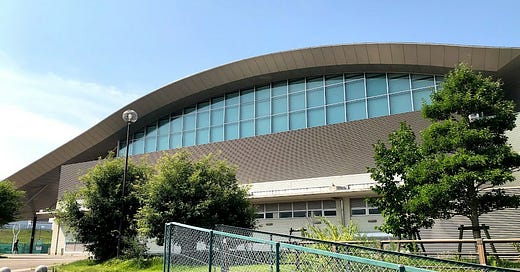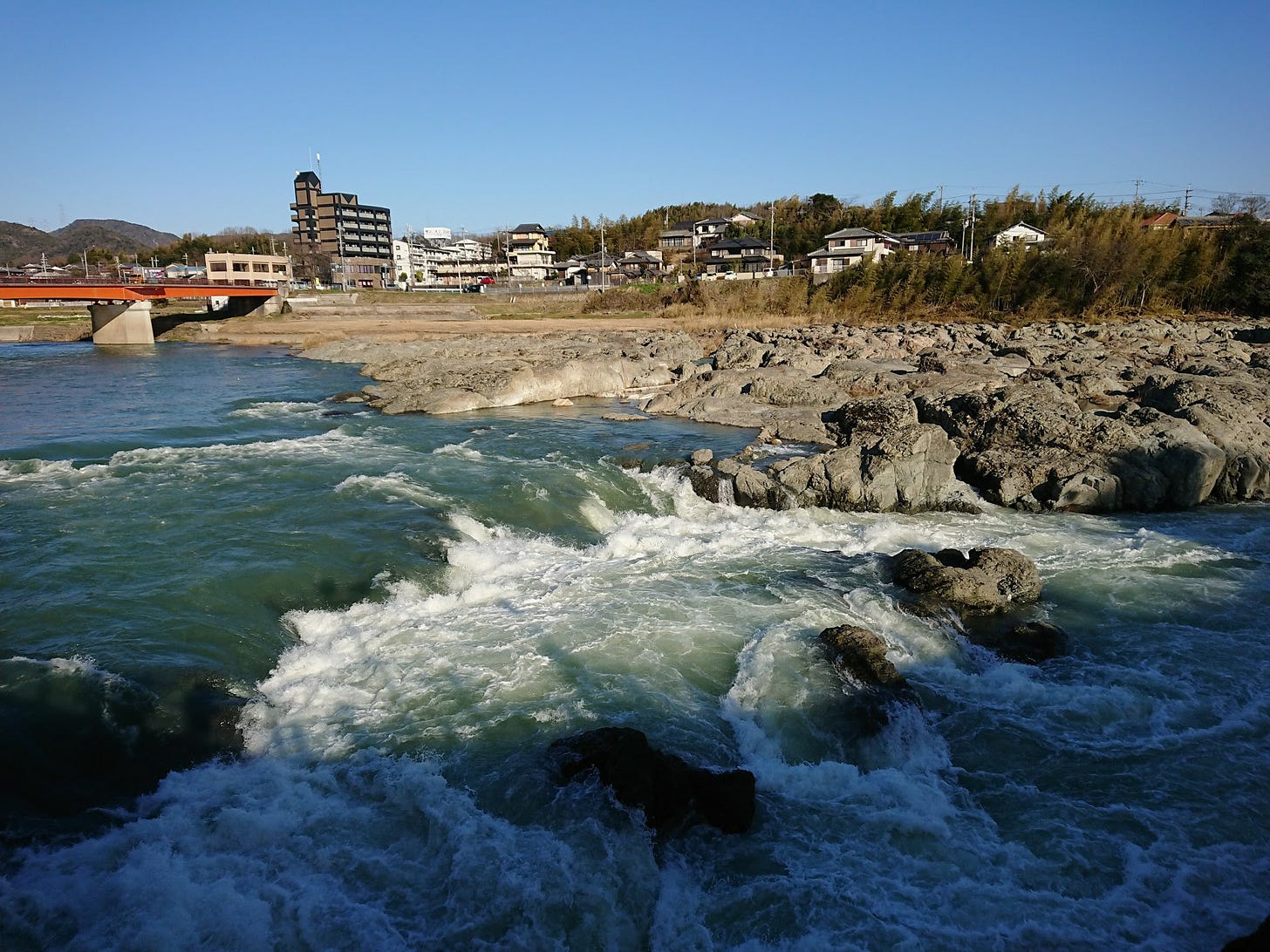The Armpit of Japan
From Yashirocho to Nishiwaki along the Japan Standard Time Line
I returned to Yashirocho the next day. I had a vague notion that a friend lived somewhere around here, but when I contacted him to see if he would be happy to join me on a walk, it turned out he lived right here in Yashirocho. Getting back to the town was not quite as easy as I thought it would be. Having taken a train directly down the Kakogawa valley to Kakogawa city, changed onto a rapid express train and returned home within a couple of hours on my previous return journey, I expected a similar time frame for my journey back to Yashirocho today. I assumed the final destination shown on the front of the train was beyond Yashirocho. Instead, the train terminated with considerable customer confusion at Ao. It probably wasn’t very confusing for the Japanese passengers, but nearly everyone in my carriage was Vietnamese. They spoke no English, so we had to manage with our imperfect Japanese. It turned out they were on their way to work at a packaging plant farther up the valley. We ended up waiting at Ao station for more than thirty minutes before the train onwards up the Kakogawa arrived.
Eventually, I arrived back at Yashirocho, an hour later than I had told my friend. Luckily, he lived close to the station and came to meet me after I let him know I had finally arrived. We set off, under another typically clear Japanese January sky, although hazier than yesterday. I told him about my train journey experience.
“Yes, I think you need a car to live here.”
It was true. Even commuting to Kakogawa would be a pain with the long transfer times at Ao. Commuting to Kobe or Himeji would be out of the question. In my last post I called this deep inaka, but in truth we weren’t there yet. The mountains had barely begun, and we were close to the E2A expressway which runs farther inland, parallel to the E2 expressway - the main expressway along the Inland Sea coast. The proximity of the expressway explains the large logistics park just outside Yashirocho. It was probably there that the Vietnamese were headed.
We continued following the Kakogawa northward, walking right along the embankment, passing pumping stations and pipes that crossed the river. After passing under the E2A expressway, the road was being reconstructed, a new bridge put in. A set of fresh concrete steps led up to some kind of memorial. For a change, there was someone to ask what this might be. My friend thought it was probably a war memorial. Unlike those in England, usually well cared for and surrounded by the remnants of poppy wreaths from the previous November Remembrance Day, this looked forgotten, weeds grew all around. Would those fresh concrete steps ever be used?
I wanted to get back on the riverbank again. But this too was being reconstructed. I wondered how necessary it was to keep reconstructing these riverbanks and lining them with concrete tiles. I asked my friend whether it was possibly just a Jiminto (Liberal Democratic Party) boondoggle, but he didn’t seem to think so, and scoffed at my questioning of it when I admitted I knew nothing about riverbank engineering.
A good chunk of research revealed that lining the riverbanks with this concrete tiling (called revetments) was pretty standard to stop seepage through the embankment. Alex Kerr, in his book “Dogs & Demons: Tales from the Dark Side of Japan” bemoans the concreting over of the Japanese countryside. Concrete revetment-lined rivers do not look nice, but rivers in Japan essentially act as large drains. Japan has roughly three times as much rainfall per year as the UK, but it tends to fall in short heavy periods. Coupled with steep mountains, and small plains, the heavy rainfall has to be moved quickly from the mountains out to sea without flooding the valuable land on the plains. There’s no leeway, if the riverbank is breached, there’s always something immediately next to it that will be flooded - housing, factories, intensively-cultivated farmland. On previous walks, I had seen them clearing bamboo near rivers. Was this a good idea? Wouldn’t the bamboo help knit the soil and prevent erosion? Well, not so much. Bamboo rhizomes and root systems are very shallow, but the bamboo clump above ground is very heavy. The roots only hold a very small layer of soil together; once the slope exceeds 40 degrees, the whole heavy bamboo clump with shallow root system tends to slide into the river as it gets undermined. The bamboo I had seen being cleared from the level riverbed was presumably being removed as it was an impediment to the water flow to the sea. From this point on, I kept my eyes open for anything that could be considered unnecessary concrete or reinforcement of riverbanks. I never saw any.
While the constant riverbank reconstruction that frequently and annoyingly knocked me off my desired riverside route may not be a boondoggle, the same probably cannot be said for the oversized community centres I passed. Takino Sky Pia, is a fancy airport terminal-style building for what is essentially a large school gymnasium. Just across from this is a 400-seater auditorium, the size of venue usually reserved for large university campuses, or smaller West End of London theatres. These are for a town (Takino) that has a population of around twelve thousand.
Takino Sky Pia - a very big school gymnasium (Google Earth)
Despite the oversized-civic amenities, Takino was a pleasant town. The name literally means “waterfall fields”. Here, the Kakogawa rushes through a natural rock weir. A concrete bridge allows access to the rocks in the middle of the river channel. We hopped around past rust-coloured rock pools and families hopping this way and that across the grey-brown ripple-cracked surface.
The Kakogawa at Takino (Google Earth)
Leaving Takino, we passed a restaurant building searching for tenants, and another building on the other side no longer even trying to search, just empty. Before you start noticing the akiya abandoned housing, it’s these kind of empty, sun-faded commercial buildings you see as you head deeper into the countryside. A little farther up the road was a closed love hotel, the purple awnings to hide visitors’ cars faded, the white tiling of the exterior walls stained with dark mould, and rust streaks down the rooftop water tank. Yet the Honda showroom next door was neat and shiny and clearly quite new. The decline of many of these businesses probably has more to do with the lack of traffic passing through here since the completion of expressways from the Inland Sea to the Sea of Japan than it does with declining population. Before the construction of the E27 expressway, this route up the Kakogawa was probably the main road that travellers from the Kansai area took to reach the Sea of Japan coast at its more beautiful locations.
The hazy sunshine had gone, the sky dulled to a flat grey. We walked along a long straight road heading into Nishiwaki City. A small factory on the right had its shutters open, so I had a peer inside to see what was being made. It looked like train wheels, and some later research revealed that they did indeed make brake disc linings for train wheels here at this tiny factory. The Japanese countryside is dotted with small factories like this, supplying bigger companies like Kawasaki, Hitachi and the like. Attracting and retaining small factories like this is crucial to keeping employment in rural communities. Will Japan’s large manufacturing companies keep sending work out to small rural suppliers like this?
We wandered across the grid of streets near Nishiwaki station looking for somewhere to eat. My friend bemoaned the lack of restaurants and life in general in Nishiwaki. I was sure I had been here once before on a camping trip, and remembered a lively pleasant festival by a river. None of this was evident in mid-winter. There were more permanently-closed shops and commercial units, but these were interspersed with new houses and a new juku cram school. The closed shops were pharmacies and hair salons, the typical replicative entrepreneurship that works reasonably well with high population densities. With falling populations however, supporting so many of the same kind of shop in such a small area inevitably means hardly any of them are economically viable.
Not many places were open, but eventually we found a Mos Burger restaurant and tucked into their sloppy, spilly burgers. My friend had sunk into a funk. He didn’t want to show me this! Why would I want to see this part of Japan? Didn’t I want to visit Takeda Castle (known as the Japanese Machu-Picchu) instead? Or maybe somewhere beautiful on the Sea of Japan coast? Not Nishiwaki surely? And as I looked out of the window at a sun-bleached second-hand bookstore and one hundred yen shop on a grey winter’s day, I could see his point. But I wanted to see real, rural Japan. Not a tourist resort. After three continuous days of walking, my enthusiasm for this journey across the middle of Japan was beginning to wane too. It was time to take a rest, I would return to the Japan Standard Time line during the Golden Week holidays.
The Chinese character 脇 (waki) does have one meaning that roughly translates as armpit or under the arm. So, Nishiwaki could be literally translated as “western armpit”, which would fit with my friend’s feelings about the place. Its more likely meaning in the context of a place name is as a branch or subsidiary. Possibly it refers to a branch road or a western tributary of the Kakogawa river.







Quote of the week: "We found a Mos Burger restaurant and tucked into their sloppy, spilly burgers."
How true! Though I'm sure MOS is not going to adopt that phrase as their new slogan anytime soon.
I like those burgers but boy, are they hard to bite into. I always end up making a mess.
Also, how fitting that you ate at MOS while in the middle of a walk where - I quote again - you wanted to see real, rural Japan. After all, MOS means Mountain Ocean Sun.